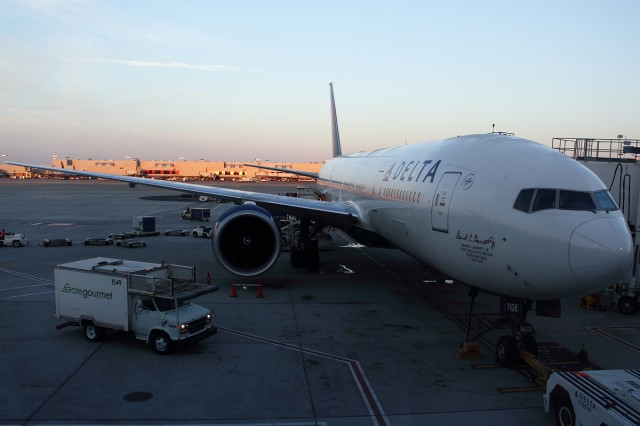
Delta Boeing 777-200LR in Atlanta. Notice the special signature on the nose. Photo by Brandon Farris.
I recently had the opportunity to fly from Atlanta (ATL) to Los Angeles (LAX) on Delta Air Lines flight 110, that was operated by a Boeing 777-232LR. Being the AvGeek that I am and having never flown on a 777 I just couldn’t turn this opportunity down.
I hopped on a red eye out of Seattle (SEA) that got into ATL at 05:30am giving me nearly 3 hours for my connection. I believe it literally took me maybe 20 minutes to get from where my SEA plane was parked in the B gates to gate F4 where I lay eyes on N708DN, a 2009 777-232LR that would be my ride back to the west coast. This aircraft is dedicated (with a special logo on the nose) to Delta’s former CEO David C. Garrett Jr who served for the airline from 1978-1987.
Being that I was at the airport so earl,y not many shops were open yet, so I mingled around the terminal where I saw a Boeing 767-432 arrive from Rio as DL60 and an Airbus A330-323 pushed back at 06:10am and depart as DL8860 to Saint Martin which was a surprise.
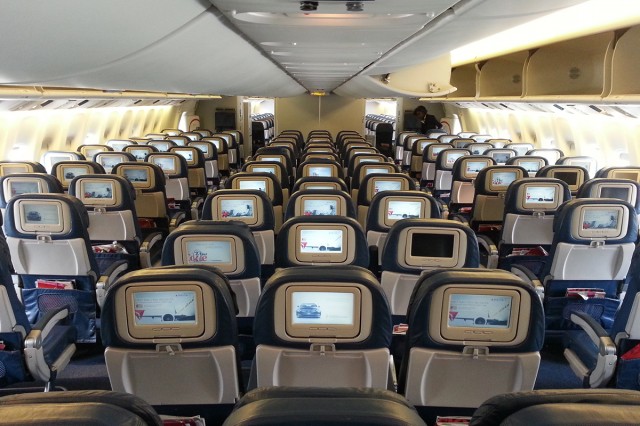
Delta configures their 777’s in a 3-3-3 layout. Photo by Brandon Farris.
Gate agents finally arrived around 07:00AM for our 08:10AM departure, at this point I was assigned 53E which is literally middle middle on this aircraft as it is a 3-3-3 configuration in the coach cabin.
It finally approached time to board, but were told that there was a slight delay with the cleaning crews onboard the aircraft and boarding would begin as soon as possible. Once boarding began I waited until the very end to get on since all I had was a backpack and wouldn’t require any overhead space.
Walking down the jetway the excitement began to settle in that I was about to step foot on my first ever 777 flight even if it was domestic, it is still a 777. By the time I boarded near the end, it didn’t take very long to get to my seat near the very back of the aircraft.
The time was now 0819 and our push-back began, only 9 minutes late so not too shabby. This was the part that I was most looking forward to; that howling growl start of those amazing General Electric GE-90’s as they spool up and come to life. I heard the first one start and it was like music to my hears. I know that I had the biggest and dorkiest smile/look on my face like a 5 year old. Yes I am in love with that howl!
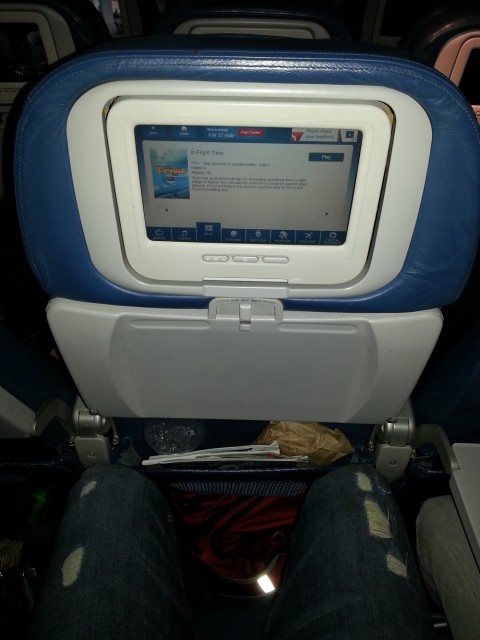
Delta’s Economy in-flight entertainment. Photo by Brandon Farris.
Following the push-back, we begin our taxi out. The pilot came on the intercom and alerted us that we are number five for departure, 19 minutes after departing the gate the aircraft begins to turn on the runway. I was ready to feel the full 220,000lbs of thrust but since we were so light with only going to LAX the pilots really didn’t seem to throw the throttle that high. It didn’t seem very long for us to climb to our cruise altitude of FL400 as we headed west. I must admit that this was one of the quietest cabins I have flown on at cruise.
Now, I had the opportunity to check out the seats. They seemed very wide which I absolutely loved but at the same time each row is extremely narrow to where my knees were almost in the seat in front of me (I am 6’0″). I couldn’t imagine if someone had been sitting in front of me and reclining the seat. It would have crippled my space, in a long haul flight I definitely would consider upgrading to the front cabin if possible, but luckily this was a shorter flight.
The lack of leg space however was made up for with the ability to plug my phone in to charge and a seatback TV which had a very wide array of movies to choose from including ones that had just come out on DVD last week like Life of Pi, to classics like The Goonies.
I choose Lincoln, but since I was so tired, I fell asleep about 20 minutes into it and I actually took a nap for about 3 hours. When I woke up, the cabin crew was coming through with a final beverage service. As a part of the service, they offered three choices for snacks: pretzels, peanuts or the infamous biscoff cookies. This was a welcome change as I am just used to the standard AM or PM snack depending on when my flight was.
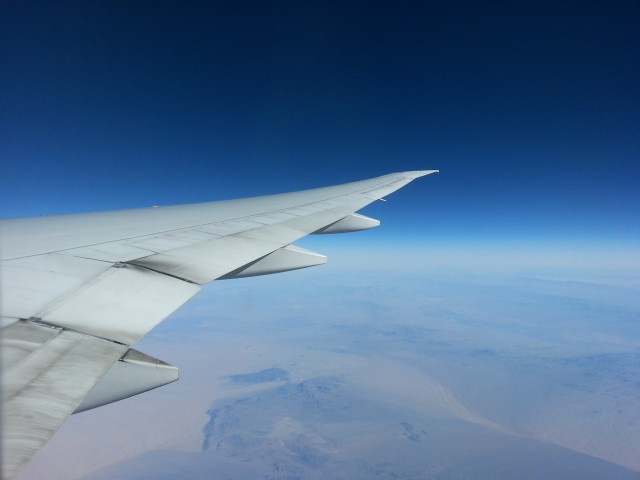
Flying on the 777. Photo by Brandon Farris.
At this point we were now about 40 minutes out from LA so I decided to get up and stretch a little and see if I could find a window to peak out somewhere and at least get a couple of pictures and was lucky to find that the cabin doors all have windows and was able to snap away for a couple of minutes. I also took this opportunity to visit the lav to find it was surprisingly very spacious.
But now it was time for me to return to my seat as we began our descent into LAX and was a fairly smooth approach. We landed on 25L and the pilots brought us in very gently before I was able to hear the roar of that GE-90 as the thrust reversers were kicked in. Following a short taxi we parked at the gate at 0957, three minutes early even after the late push.
Deplaning was brief, only being about 15 minutes from the back of the plane. I had the opportunity to talk to the pilots and was invited to make a brief visit to the flight deck before finally leaving the aircraft.
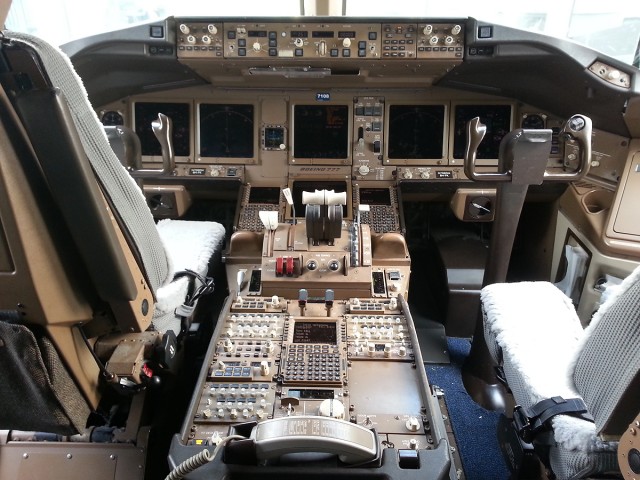
Flight deck of the 777. Photo by Brandon Farris.
Overall for this being my first time ever flying on Delta and the Boeing 777 I was extremely impressed on both fronts. The gate agents were extremely friendly which can be rare to find, especially at 0600 and 0700 in the morning. The inflight crew was great and was willing to answer any questions I had. It was nice to see such happy and helpful employees working for Delta after I have heard mixed reviews. Now to try and test out the 777 on a longer flight.
NOTE: Brandon covered the cost of this flight on his own and it was not paid for by Delta.
 |
This story written by…Brandon Farris, Correspondent. Brandon is an avid aviation geek based in Seattle. He got started in Photography and Reporting back in 2010. He loves to travel where ever he has to to cover the story and try to get the best darn shot possible.
@BrandonsBlog | RightStuffPhotography | Flickr |
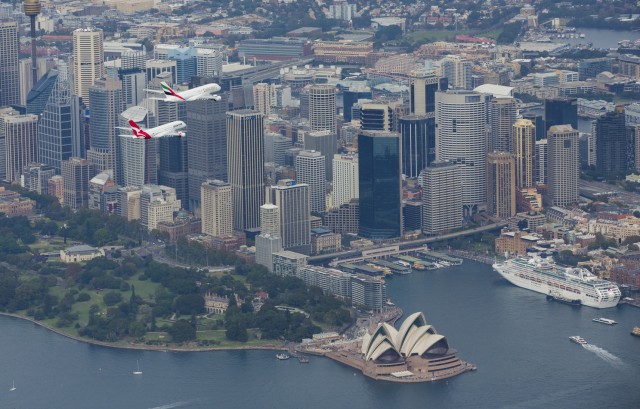
A Qantas and Emirates A380 Fly in Formation over the Sydney Opera House – Photo: Qantas Airways
On Easter Sunday in Sydney, many families spent time to calm down the sugar loaded children while the sun hides amongst the clouds in the southern autumn (fall). Yet in the sky, a unique event happened, never seen before.
To commemorate the start of the partnership between Qantas & Emirates the two airlines decided to hold a special event. At 10:30am, at 1500ft above the Sydney Harbor Bridge an A380 from Qantas, flew in formation with a second A380 from Emirates. This is the first time in aviation history that not only did two A380s flew in formation, but also two from different airlines.
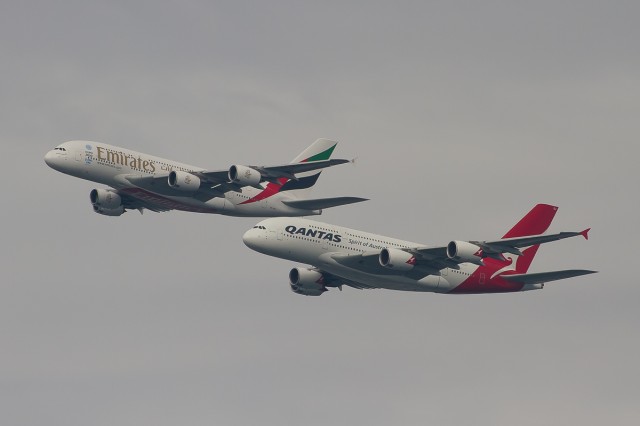
An Emirates A380 flies High and to the Right of the Qantas A380 – Photo: Bernard Proctor
’œThe sight of two of the world’s great airlines flying two of the world’s largest aircraft so close together over Sydney Harbor is a once in a lifetime opportunity,’ said Captain Green Chief pilot for Qantas.
Pilots from both airlines have conducted dozens of special simulator training sessions since January this year. Emirates pilots came to Australia earlier this month to conduct joint sessions in Qantas’ A380 simulator in Sydney and conducted several more practice runs over the past few days.
As VH-OQF (from Qantas) & A6-EDY (from Emirates) flew over Sydney Harbor they used the call sign ’œSeismic’ because Emirates President Tim Clark said ’œthe partnership between Qantas and Emirates will cause a seismic shift in global aviation.’
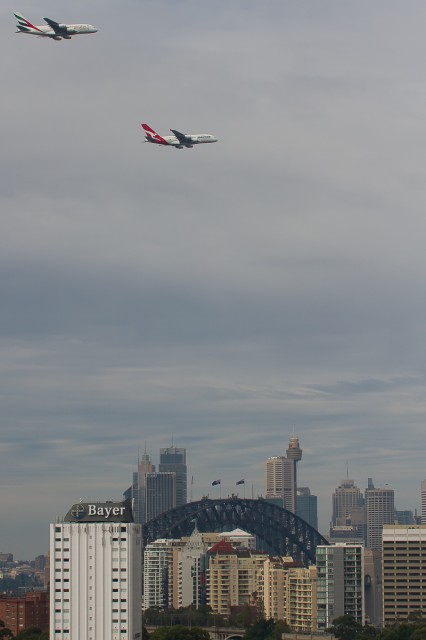
The two A380s fly over the Iconic Sydney Harbor Bridge – Photo: Bernard Proctor
The Qantas & Emirates partnership is game changing, as it sees the end of the dominant force on the ’œKangaroo Route’ from London to Australia via Singapore. That traditional route was maintained by an agreement between British Airways (IAG) and Qantas for over 15 years. Although Qantas & British Airways are oneworld partner airlines the joint agreement allowed them to coordinate pricing, services and flights between the UK & Australia. However when that agreement ended on the 31st of March, the Emirates partnership began.
With Qantas flying their A380s to London via Dubai, it allows Qantas customers access to 70 destinations in Europe with only one stop over the previous two. Emirates doesn’t come out of the deal empty handed, as they get access to the Qantas domestic network, which is by far the most comprehensive in Australia. Frequent flyer benefits and some on-board services have been aligned between the two carriers making this a true powerhouse to contend with.
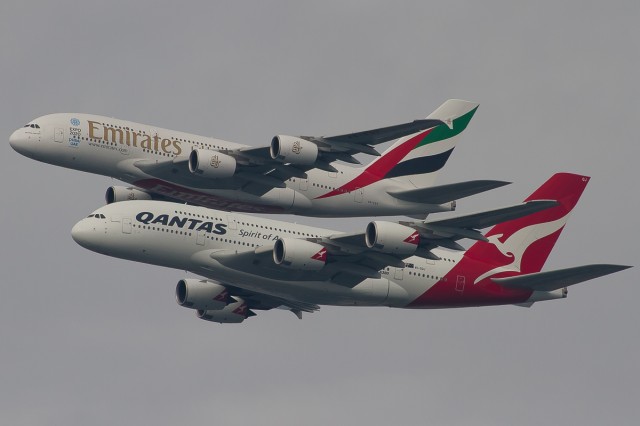
The First time two Different Airlines have flown in Formation – Emirates & Qantas – Photo: Bernard Proctor
I can just imagine standing by the shoreline on Sydney Harbor seeing these two large aircraft flying in formation and being surrounded by a stunned crowd of AvGeeks, tourists & locals. It is only too bad that the sun and blue sky were not out.
 |
This story written by…Malcolm Muir, Lead Correspondent.
Mal is an Australian Avgeek now living and working in Seattle. With a passion for aircraft photography, traveling and the fun that combining the two can bring. Insights into the aviation world with a bit of a perspective thanks to working in the travel industry.
@BigMalX | BigMal’s World | Photos |
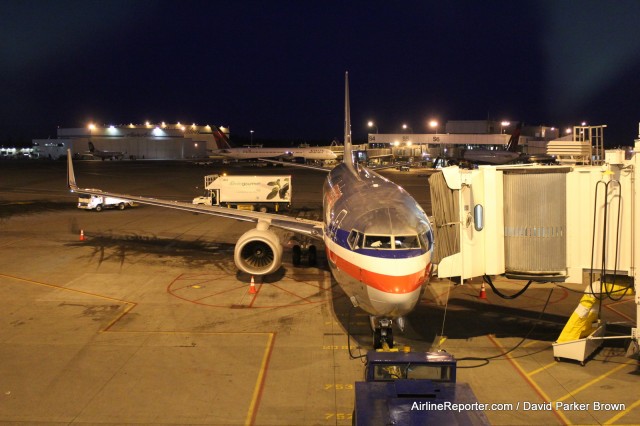
American Airlines Boeing 737-800 in Seattle.
It takes quite a bit to get me up at 4am. Having the chance to spend about 40 hours flying on a premium product is just about enough to do it. I was recently invited to check out American Airlines new Boeing 777-300ER on a flight from New York (JFK) to London (LHR). I was set to leave at 7am on Monday and be back home by 10pm the next day. This was going to be one heck of a great #AvGeek adventure (note: American covered all my flights).
It did not take too long to get ready for my trip. One back-pack with a change of clothes, laptop and camera. Soon enough I was sitting in my car ready to rock and roll. I turned the key… nothing. Tried again and once again nothing. Oh boy.
After ten minutes of messing with my main vehicle, I decided to take my secondary car which is a 1987 Ford Bronco. Oddly, it is not known to be very reliable, but I was going to have to take the risk and started the 45minute drive to SEA. Hopefully this was not a sign of things to come.
Even with my vehicle issue, I was able to make great time to the airport, parked and made my way inside. With longer trips, I will find alternative parking options, but with getting to the airport at about 5:30am and scheduled to return the next day at 10pm, I decided just to park on-site and pay the $28 per day (heck, I get extra miles to boot).
With just one bag, normally getting to the gate would be a breeze. But I had a non-rev media ticket and with most airlines, I am not able to check in online and need to go to a ticket counter. No worries, I was flying First Class from SEA to JFK and had a priority line waiting for me — maybe.
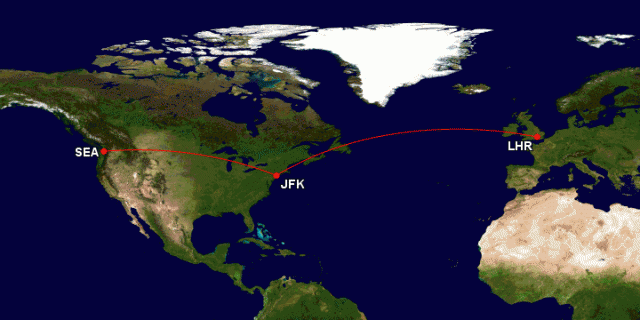
Almost 12,000 miles in less than 40 hours.
Walking up to the counter the economy line had about 20 passengers, but my special line had no one — bonus. Unfortunately the agent working the First Class line was was on the phone, but I figured I could wait a few minutes, but at the five minute mark it got a bit annoying. The agent had not even looked up to let me know that he knew I was there. Not a huge deal, but a simple recognition that I existed could have gone a long ways.
Instead of waiting on the ticket agent, I decided to give an open kiosk a whirl. About half the time they work with the media tickets and the other half they do not. The good news is it seemed like it was going to work, but the darn thing would not scan my Passport. Luckily there was a nice woman there who was able to quickly help me and get my boarding pass with a smile and I was off to my gate.
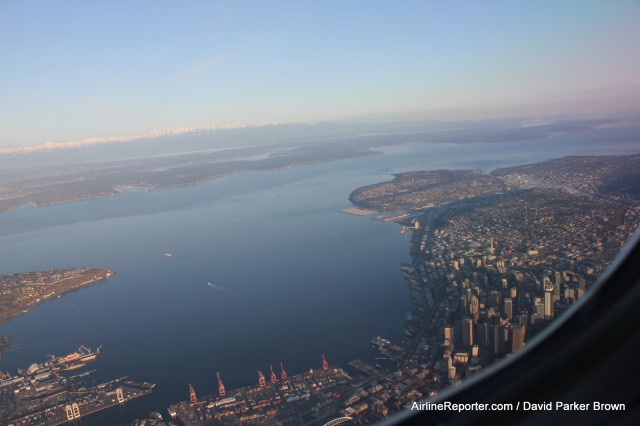
Lifting off from Seattle. Do not fret that I have my “electronic” camera device on below 10,000 feet. I had permission from the airline!
My premium ticket was also able to get me quickly through the security line with only one person in front of me versus the 50 of so in the main line. SEA operates body scanners at each check point, but to date, I have still not been scanned at my home town airport (and only twice ever other places — darn you AMS and TPA). Per usual, the TSA were operating scanners at two of the four bag scanners and I was easily able to choose a line without a scanner. I am by no means a fan of the body scanners, but if you are going to operate them, at least do it in a fashion where they are not so easily avoidable.
However, the TSA made it up to me during boarding when my bags were randomly selected to be searched. I have to say that the two TSA gate agents were some of the nicest I have interacted with and I am really glad I went with a conservative pair of boxer shorts.
Boarding was quick and easy. I was greeted by my last name, my jacket was quickly hung up and offered water, juice or champagne — classy. This level of attentiveness remained the entire way to JFK and honestly is not what I normally expect when flying domestically, even in First Class. Realize this has nothing to do with me being media. I was not taking any photographs inside the aircraft and everyone was receiving this same level of treatment. I was impressed.

Landing at JFK where the weather was not too pleasant.
Lifting off from SEA on a clear day is always a great reminder how much I love the town and the surrounding area. It might be a shocker for some of you, but many take offs I experience are cloudy and gray.
Once hitting the 10,000 feet mark, I was excited to get back online. Fired up my laptop and went to connect to the GoGo in-flight internet. Then I saw the costs: $10.00 for an hour, $20.00 for three hours, or $21.95 for the entire flight. I get the fact that most people on business travel will just expense this out and that it costs money to provide the internet, but this was just too much for me at the time. I think if it were $15, I would have gone for it and was thinking I might do the $10.00 during the 3rd hour in the flight, but sleep got in the way.
The American domestic First Class seats not only have a decent recline, but they also move the bottom of the seat forward. One of my favorite features was the arm rest next to the window is able to raise, allowing access to the additional space by the wall. This provided ample comfort to get in a few hours of sleep, so I could be well rested for my 777 flight.
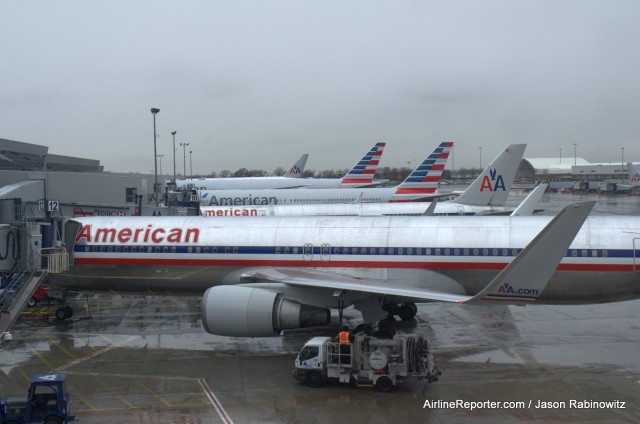
A few American Airline tails at JFK.
It had been a while since I flew into JFK. Many airports, you land and it only takes a few moments to get to the gate. Not here. Post landing, it took a good 20 minutes before we arrived at the gate. At least I had a window seat and was able to spot planes turning green.
After collecting my things, I was on the jetway, checking my email on my phone and missed the gentleman who was there to great me: Phil Derner Jr who runs NYCAvitiation.com. A nice little surprise. Also, Jason Rabinowitz (who writes for both of our sites), was also on his way to join us to help me take photos of American’s 777-300ER. It was a mini AvGeek get-together.

AveGeeks Unite! Me, Phil Derner Jr with NYCAviation and Jason Rabinowitz aka @AirlineFlyer pose at JFK.
To celebrate our gathering, we took a photo in front of a JFK/American backdrop that was at some random gate. I forgot I was not in Seattle anymore and when I asked a gentleman sitting by us if he would take a photo, he looked at me like I was nuts. Luckily a nice lady next to him offered and after about five attempts, we ended up with one that was not super blurry.
After our photo shoot, we were off for some beers while waiting for the American Airlines representative to escort us on to the aircraft.
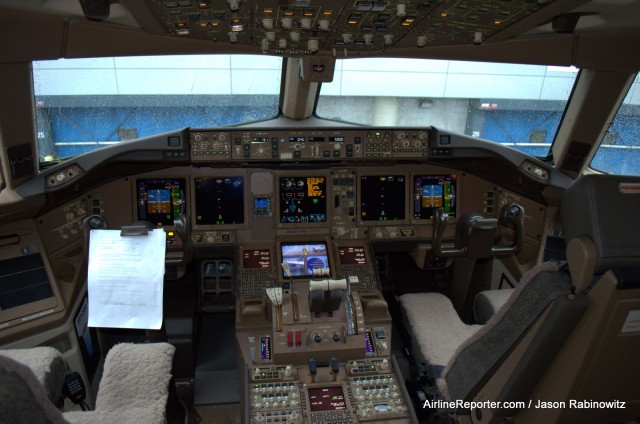
The flight deck of American’s Boeing 777-300ER.
Soon, it was time to pre-pre-board the 777-300ER. I have found trying to board super early provides much better photos than rushing around with a bunch of passengers. This also allowed us to view First Class, economy, the flight deck (bonus) and the crew rest areas.
I found it pretty interesting that multiple American employees kept boarding the plane to take a look at the new plane and interior. I think that shows the excitement that the new aircraft is bringing to the company. After getting everything we needed, we de-planed, Phil and Jason went back to their normal lives and I was back on the Worldliner 15 minutes later prepping for my flight to London.
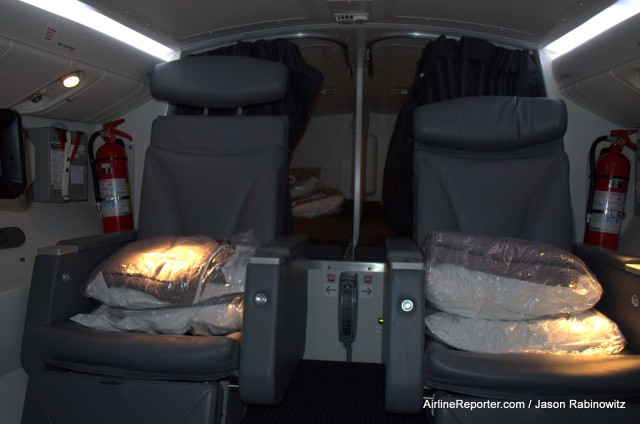
Pilot rest area located above the main deck in the front of the 777-300ER.
Then I took off, flew for a bit and then landed. Awesome review right? Do not worry, a full story on the flight is coming soon, but for now, the 40 hour adventure continues (minus the actual 777 flight). Insert cheesy time transition here.
We arrived at the gate a little late, but still giving me about six hours in London before getting back on the same plane and heading to New York. It was time to find the lounge.
Unfortunately, I avoided customs and was able to head to “connecting flights,” go through security, check in and be ready to go. I say “unfortunately,” because this means I did not get my Passport stamped — I know, tough life.
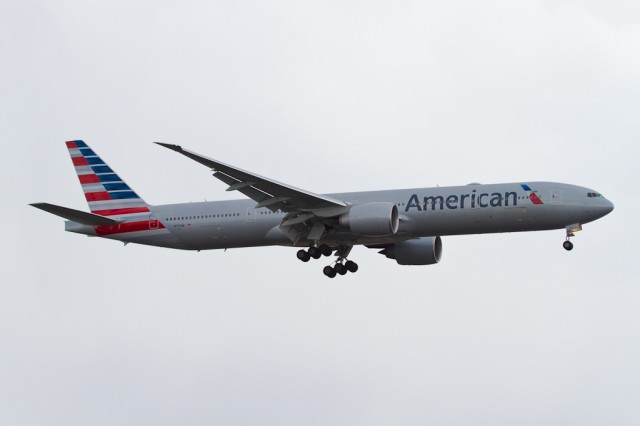
My American Airlines Boeing 777-300ER landing at JFK by Eric – SouthPawCaptures.
At the lounge I was looking for two main things: coffee and a shower. Luckily it had both. I was able to keep productive (and hydrated) waiting for my return trip home. My departure time was 12:30pm local time, but that was 5:30am at home. I had not been able to sleep too much, so by the time we boarded, I was exhausted.
I found my seat, got situation and then… BAM, it was four hours later. I must have woken up at some point, since my seat was fully reclined. I do not remember taxi, take off or the missed meal service (again more details on my 777-300ER flights later).
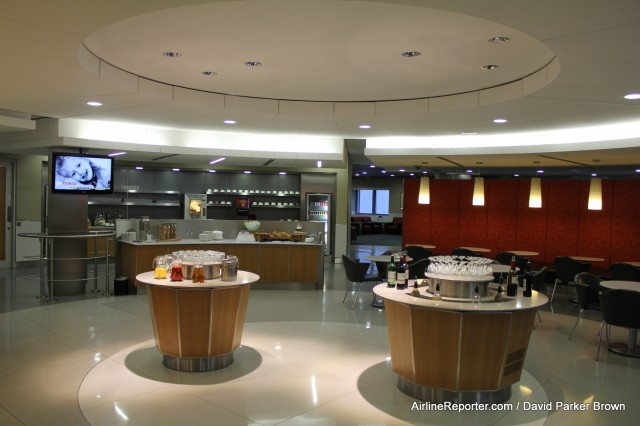
Admiral’s Club in London — my home for about five hours.
I was once again back at JFK. When going though customs, I was some-what excited to be asked about my trip and how long I was in London. Maybe even get additional screening from having such a weird story. Instead I was greeted by probably the nicest Customs official I have interacted with, but no questions about “how many days were you in London?” Oh well.
After going back through security, I found the Admiral’s Club and relaxed for about an hour before taking my final leg back home to Seattle. Once getting settled in my seat, the captain came on to let us know that the flight was going to be a “home coming” for the 737, since it was built in Renton. Awesome — I like this guy.
My flight back to Seattle started very similar to my flight back to New York. Boarded and back to sleep I went. Upon waking, one of the flight attendants noticed and asked me if I wanted one of the meals — nice. Most times when sleeping through a meal service, I have to ask. I ate some sort of beef (I forgot to grab the menu), but I was too full to have another ice cream sundae (I had one on the 777).
The flight landed back in dark SEA about 30min early. In less than 40 hours I had just flown about 12,000 miles. I always have wondered if I have a limit on how much I can fly before I get tired of it. This was as close as I have gotten, but after a nice rest in my own bed, I would have been ready to hit the sky again.
I will go into a bit more detail with my next story, but I ended up with noticeably better service on my domestic American Boeing 737 flight than I did with the international 777 flight, but the product on the 777 was strikingly more impressive. The interesting part are the flights are about the same length.
It leaves the big question: does an amazing product with mediocre service trump a mediocre product with great service? Stay tuned for my answer and put your thoughts in the comments.
SEE ALL 76 PHOTOS FROM THE AMERICAN AIRLINES TRIP
 |
This story written by…David Parker Brown, Editor & Founder.David started AirlineReporter.com in the summer of 2008, but has had a passion for aviation since he was a kid. Born and raised in the Seattle area (where he is currently based) has surely had an influence and he couldn’t imagine living anywhere else in the world.@AirlineReporter | Flickr | YouTube |
It is that time of year again for airlines and organizations related to aviation to come out with crazy stories for it being April Fools’ Day. Once again, we will try and track them down and share them. If you see others that are not covered here, leave something in the comments.
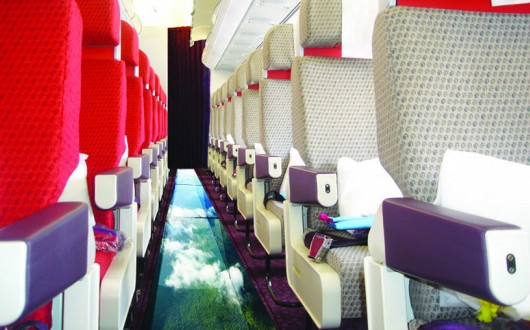
This is something that AvGeeks might like, but probably not most passengers. Image from Virgin Atlantic.
VIRGIN ATLANTIC TO OFFER SEE-THROUGH FLOORS:
From Richard Branson: I’m thrilled to announce that Virgin has created another world-first with the introduction of the technology required to produce the world’s first glass-bottomed plane. This technological innovation coincides with the start of Virgin Atlantic Airways’ first ever domestic service to Scotland.
In 1984 we started the wonderful airline that is Virgin Atlantic. I am incredibly proud of yet another aviation breakthrough which has been years in the making. I can’t wait to experience the first flight for myself with my family and other natural born explorers.
Read more and see some pretty sweet mock-up photos…
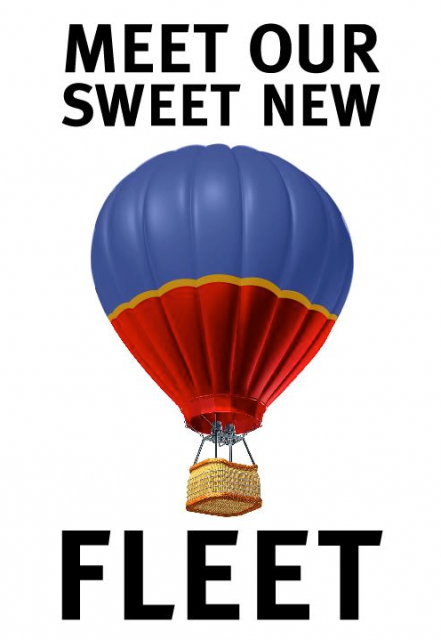
Take a Southwest Airlines hot air balloon. Image from Southwest Airlines.
SOUTHWEST AIRLINES ADDS HOT AIR BALLOONS
From the airline: When you’re flying nearly 500mph at 35,000 feet above ground, life passes by pretty fast. Sure, Southwest has a suite of things to keep you entertained inflight: Video on Demand; WiFi; Live at 35; hilarious Flight Attendants. Heck, we’ve even transported a miniature seeing-eye horse, and a couple endangered sea turtles. But figuratively, you can’t have the hare without the tortoise.
Realizing the possibility that slow and steady may truly win the race, the answer became clear: it was time to float the grandest idea Southwest has ever had. It was time to take things slow. The tortoise and the hare. Hot air balloons and Boeing 737’s, soaring fancy free, albeit at distinctly different altitudes, and at significantly separate speeds.
Read more…

Flying does not have to be “ruff” any longer. Image from Virgin America.
MAIN CANINE SELECT WITH VIRGIN AMERICA
From the airline: We’re of the mind that man’s best friend shouldn’t get the raw deal when flying long distances, so we partnered with Boo, World’s Cutest Dog and our very own Pet Liaison to throw furry flyers a bone. Over the last year (and with Boo’s doggy design expertise) we’ve converted our first class cabin into a space as tricked out as our state-of-the-art digs at SFO’s Terminal 2.
See more images and learn more…

JetBlue adding more destinations? Probably not really these ones. Image from Jeremy Dwyer-Lindgren.
JETBLUE FLYING TO THREE NEW DESTINATIONS
From the airline: We’re excited to announce three tantalizing new destinations, expanding this fun-loving airline’s borders to three new countries and giving travelers more options for flying to some of the farthest-reaching dots on the globe, including:
- April River Airport (APR) in Papua New Guinea;
- Ilford Airport (ILF) in Manitoba, Canada; and
- Gold Coast Airport (OOL) in Coolangatta, Australia
Customers looking to climb an active volcano in Rabaul Caldera, experience a new sub-zero Canadian vacation spot or visit their Coolangattan relatives can now hop a flight with their favorite, customer service-friendly carrier. Once-daily flights to all three new destinations will be offered from our existing stations in Portland, Maine and Aquadilla, Puerto Rico. Twice-weekly flights will also be offered between Papua, New Guinea and Coolangatta, Australia with connecting service in Ilford, Canada(a).
Keep reading and see video…
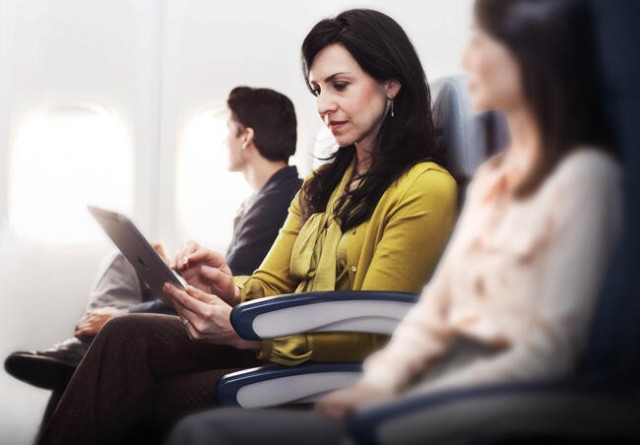
More room for the arms. Image from Delta.
DELTA DOUBLE DECKER ARM REST
Posted on Delta’s Twitter account: Introducing the new Double Decker Armrest coming soon to the middle seat. More arm space. Less elbow rubbing.

WestJet’s new animal policy might be a Baaaaad idea. Image from WestJet’s video.
ALL ANIMALS ON BOARD WESTJET
From the airline: WestJet today announced the easing of restrictions on pets in the cabin. All WestJet flights will now allow for any type of animal to travel in the cabin provided it fits safely on board the aircraft.
“We recognize that a growing number of families want to travel with their ‘extended’ family and we are proud to be the first airline to offer this type of service,” said Richard Bartrem, WestJet’s Vice-President, Communications and Community Relations.
Thanks Allen for finding this one.
Be sure to check out WestJet’s video…
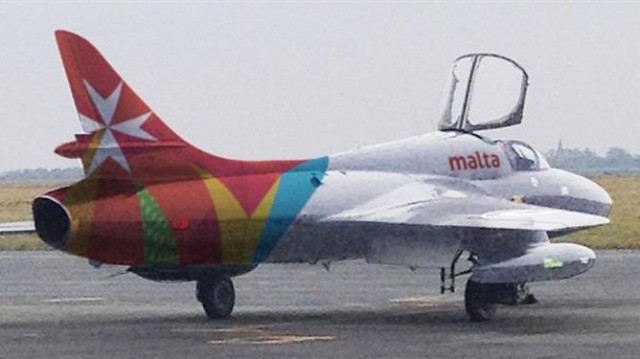
Air Malta to buy a Hawker Hunter?
AIR MALTA BUYS A FIGHTER JET
From the Malta Independent: Air Malta has bought a 1950s privately owned two-seater Hawker Hunter fighter jet. The historic airworthy military aircraft will be painted in Air Malta’s new livery and will be used to generate new revenue streams for the airline. The aircraft will also be used to promote Air Malta and the Maltese Islands abroad by participating in a number of air shows around the world.
Plans have already been made by the airline for a soon-to-be-launched novel product ’˜Jet Fighter Adventure Flights’ – an adrenalin rushing thrill seeking fighter aircraft experience that has become very popular in several countries around the world. These flights-of-a-lifetime will be available for purchase on the airline’s website www.airmalta.com.
With its sleek design, brilliant handling and maneuverability, the Hawker Hunter aircraft will offer customers the opportunity to experience a historic flying adventure. The classic Hunter was one of the best transonic jet fighter aircraft and formed the backbone of the Royal Air Force’s jet fighter squadron in the late 1950s. The aircraft was withdrawn from active service in 1995. During the 1960s and 1970s Hawker Hunter aircraft were a common sight at Malta’s Luqa airfield.
Keep reading…
PREVIOUS AIRLINE JOKSTERS:
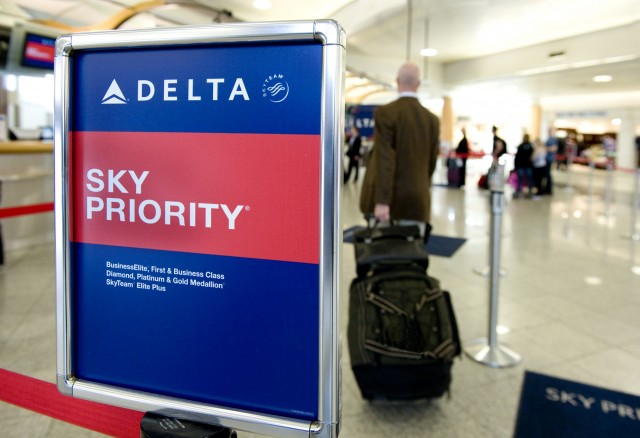
Delta Sky Priority Check In just one of the perks given to their Elite Medallion members – Photo: Delta
This is a second leg (part) in a multi- leg series. Make sure to read LEG 1 first.
Previously, I mentioned that you can get some pretty sweet benefits being an elite frequent flier and hope to expand on the idea a bit more on this part, which deserves a whole article on it’s own.
Unlike earning points, the benefits come once you have achieved that elite status and each airline has different benefits they will give their elites. Most of the airlines though tend to give the big three:
1) Priority Boarding – This means you get to board before the general economy passengers, obtaining not only that precious overhead bin space, but a few extra minutes to get yourself settled without being crowded and holding up the queue behind you.
2) Priority Check In – Being able to check in without having to wait in long lines, going to the “front of the queue” almost can be worth its “wait” in gold. Getting checked in and on your way to security fast and efficiently makes any frequent flier happy.
3) Priority Security – Avoiding that long security line behind that family with 8 children and 25 bags is always a good thing. Speedily getting up to that security check point and getting through in the least amount of time possible means you can be on your way to the gate (or lounge) faster. If you are lucky enough you may even qualify for TSA Pre Check (but that’s a whole different story).
In some cases these benefits can be worth it on their own. But there are other, less common benefits, that some airlines give that really make it worth the effort:
- Bonus Points
- Seating Upgrades
- Change Fee Waivers
- Lounge Access
- Free/Extra Baggage Allowance
American Airlines & other oneworld airline elite fliers (Emerald status) allow access to the First Class lounges in their network, even if you are flying on an economy ticket. Star Alliance gives all of their Gold members lounge access as well (for a full run down on Star Alliance Gold benefits watch this snazzy YouTube video).
United Airlines Premier 1K fliers are able to make same day changes to their flights without fees and Delta gives complimentary domestic upgrades to most of its Elites (though you still have to fight the other elites for those First Class seats).
No matter what program you choose, they all offer something to their VIP customers to make them smile.

Getting an upgrade to a First Class Seat on Delta could land you in a seat like this on some routes – Photo: Mal Muir | AirlineReporter.com
I am a Star Alliance Gold and a Virgin Australia Velocity Gold. These two programs probably mean nothing to the average American flier and most airline employees around the world barely know about the airline I hold Star Gold status with (and the less that know, the better). They both give some pretty great benefits to me that other programs don’t. Just because I live in the USA (but from Australia) doesn’t mean that I need to credit all of my flying to a US based program. Virgin Australia allows me to earn status on them, while I fly on Delta, Virgin America or Hawaiian.
Some times the benefits can be a little confusing. For instance if I was flying on United, I would get lounge access thanks to being Star Gold with a non us based airline. However, If I was Star Gold with only United, I would be in the Starbucks queue like everyone else for my morning coffee and not have lounge access. So doing the research on the privileges that different programs give is important.
Mileage running is just a way to get all the things you want with a travel experience as quickly, cheaply and easily as possible. Sure mileage running is not for everyone, but if it’s for you… it can be well worth it!
 |
This story written by…Malcolm Muir, Lead Correspondent.
Mal is an Australian Avgeek now living and working in Seattle. With a passion for aircraft photography, traveling and the fun that combining the two can bring. Insights into the aviation world with a bit of a perspective thanks to working in the travel industry.
@BigMalX | BigMal’s World | Photos |






























